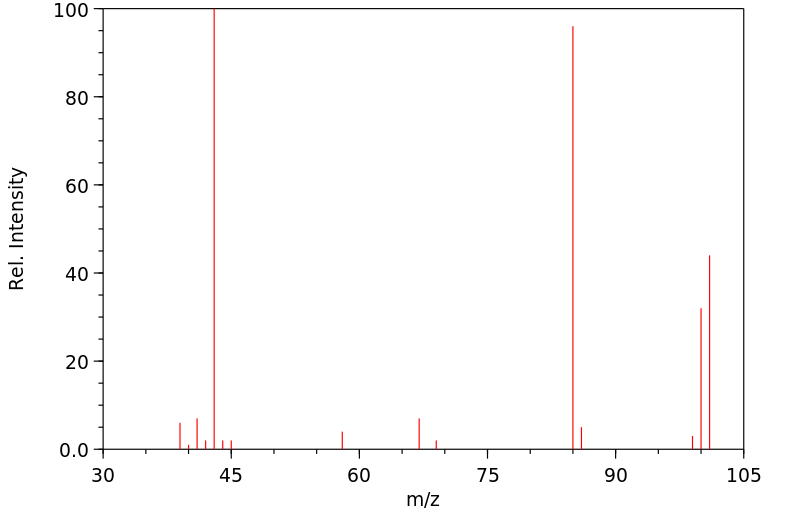3-异丙基-2,4-戊二酮 | 1540-38-1
中文名称
3-异丙基-2,4-戊二酮
中文别名
——
英文名称
3-(1-methylethyl)pentane-2,4-dione
英文别名
3-isopropyl-2,4-pentanedione;3-isopropylacetylacetone;3-isopropyl-pentane-2,4-dione;3-Isopropyl-pentan-2,4-dion;3-propan-2-ylpentane-2,4-dione
CAS
1540-38-1
化学式
C8H14O2
mdl
MFCD00048330
分子量
142.198
InChiKey
BPIHCIRSGQKCLT-UHFFFAOYSA-N
BEILSTEIN
——
EINECS
——
-
物化性质
-
计算性质
-
ADMET
-
安全信息
-
SDS
-
制备方法与用途
-
上下游信息
-
文献信息
-
表征谱图
-
同类化合物
-
相关功能分类
-
相关结构分类
物化性质
-
沸点:182-183 °C(Press: 745 Torr)
-
密度:0.9234 g/cm3
计算性质
-
辛醇/水分配系数(LogP):1.2
-
重原子数:10
-
可旋转键数:3
-
环数:0.0
-
sp3杂化的碳原子比例:0.75
-
拓扑面积:34.1
-
氢给体数:0
-
氢受体数:2
安全信息
-
海关编码:2914190090
SDS
反应信息
-
作为反应物:描述:参考文献:名称:Morgan; Thomason, Journal of the Chemical Society, 1924, vol. 125, p. 756摘要:DOI:
-
作为产物:描述:(3-acetyl-2-methyl-4-oxo-pentyl)-chloro-mercury 在 sodium hydroxide 、 sodium tetrahydroborate 作用下, 以 乙醇 为溶剂, 生成 3-异丙基-2,4-戊二酮参考文献:名称:The Reaction of Oxymercurials with Active Methylene Compounds and the Demercuration of the Resulting Mercurials with Acid and Base摘要:DOI:10.1021/jo01340a023
文献信息
-
COBALT COMPLEX, METHOD FOR MANUFACTURING SAME, AND METHOD FOR MANUFACTURING COBALT-CONTAINING THIN FILM申请人:TOSOH CORPORATION公开号:US20220017553A1公开(公告)日:2022-01-20To provide a cobalt complex which is liquid at room temperature, useful for producing a cobalt-containing thin film under conditions without using an oxidizing gas. A cobalt complex represented by the following formula (1): L 1 -Co-L 2 (1) wherein L 1 and L 2 represent a unidentate amide ligand of the following formula (A), a bidentate amide ligand of the following formula (B) or a hetero atom-containing ligand of the following formula (C): wherein R 1 and R 2 represent a C 1-6 alkyl group or a tri(C 1-6 alkyl)silyl group, and the wave line represents a binding site to the cobalt atom; wherein R 3 represents a tri(C 1-6 alkyl)silyl group, R 4 and R 5 represent a C 1-4 alkyl group, and X represents a C 1-6 alkylene group; wherein R 6 and R 8 represent a C 1-6 alkyl group, R 7 represents a hydrogen atom or a C 1-4 alkyl group, Y represents an oxygen atom or NR 9 , Z represents an oxygen atom or NR 10 , and R 9 and R 10 independently represent a C 1-6 alkyl group.
-
USE OF SUBSTITUTED ISOQUINOLINONES, ISOQUINOLINDIONES, ISOQUINOLINTRIONES AND DIHYDROISOQUINOLINONES OR IN EACH CASE SALTS THEREOF AS ACTIVE AGENTS AGAINST ABIOTIC STRESS IN PLANTS申请人:Frackenpohl Jens公开号:US20140302987A1公开(公告)日:2014-10-09Use of substituted isoquinolinones, isoquinolinediones, isoquinolinetriones and dihydroisoquinolinones of the general formula (I) or their respective salts where the radicals in the general formula (I) correspond to the definitions given in the description, for enhancing stress tolerance in plants to abiotic stress, for strengthening plant growth and/or for increasing plant yield, and selected processes for preparing the compounds mentioned above.
-
Mono-C-alkylation of β-dicarbonyl compounds using tetraethylammonium fluoride作者:James H. Clark、Jack M. MillerDOI:10.1039/c39770000064日期:——The hydrogen-bonded solvates formed between tetraethylammonium fluoride and a number of β-dicarbonyl compounds react at about room temperature with alkyl iodides to provide high yields of the mono-C-alkylated β-dicarbonyl products with no apparent contamination due to the formation of O-alkyl, dialkyl, or polymerisation products.
-
Reactivity of ambident anions作者:A.L. Kurts、N.K. Genkina、A. Macias、L.P. Beletskaya、O.A. ReutovDOI:10.1016/s0040-4020(01)98183-9日期:1971.1Effect of the alkylating agent nature in the case of O- and C-alkylation of both ethyl acetoacetate and acetylacetonate anions is reported. The value of the O/C-ratio depends on three factors: the polar effect of the alkyl substituents in the alkylating agents, the steric effect of the alkyl groups and the symbiotic effect of the leaving groups. The relative contributions of the first two effects depends据报道,在乙酰乙酸乙酯和乙酰丙酮阴离子的O-和C-烷基化的情况下,烷基化剂性质的影响。O / C比的值取决于三个因素:烷基化剂中烷基取代基的极性效应,烷基的空间效应和离去基团的共生效应。前两种效应的相对贡献取决于离去基团的性质。当离去基团为软碱(碘化物,溴化物,氯化物)且O / C比以秒为单位降低时,空间效应占主导地位。Bu> iPr> Et> Me。硬离去基团甲苯磺酸酯的情况与上述给定顺序相反的烷基顺序与烷基硬度的皮尔逊顺序相反。还报道了离去基团性质对O / C比的影响。发现离去基团对两种烯醇离子的甲基化都有很强的共生作用。在乙基化中,离去基团的作用较难检测到。对于两个仲烷基,O / C比对离去基团的性质几乎不敏感。
-
Chemoenzymatic Dynamic Kinetic Asymmetric Transformations of β‐Hydroxyketones作者:Simon Hilker、Daniels Posevins、C. Rikard Unelius、Jan‐E. BäckvallDOI:10.1002/chem.202102683日期:2021.11.11one-pot procedure to achieve efficient DYKAT of α-substituted β-hydroxyketones. This newly developed protocol offers straightforward access to enantiomerically pure and diastereomerically enriched β-oxoacetates in high yields by employing a ruthenium-based racemization catalyst for efficient racemization-epimerization of substrates via formation of non-chiral 1,3-diketone intermediates.
表征谱图
-
氢谱1HNMR
-
质谱MS
-
碳谱13CNMR
-
红外IR
-
拉曼Raman
-
峰位数据
-
峰位匹配
-
表征信息
同类化合物
(反式)-4-壬烯醛
(s)-2,3-二羟基丙酸甲酯
([1-(甲氧基甲基)-1H-1,2,4-三唑-5-基](苯基)甲酮)
(Z)-4-辛烯醛
(S)-氨基甲酸酯β-D-O-葡糖醛酸
(S)-3-(((2,2-二氟-1-羟基-7-(甲基磺酰基)-2,3-二氢-1H-茚满-4-基)氧基)-5-氟苄腈
(R)-氨基甲酸酯β-D-O-葡糖醛酸
(5,5-二甲基-2-(哌啶-2-基)环己烷-1,3-二酮)
(2,5-二氟苯基)-4-哌啶基-甲酮
龙胆苦苷
龙胆二糖甲乙酮氰醇(P)
龙胆二糖丙酮氰醇(P)
龙胆三糖
龙涎酮
齐罗硅酮
齐留通beta-D-葡糖苷酸
鼠李糖
黑芥子苷单钾盐
黑海棉酸钠盐
黑木金合欢素
黑曲霉三糖
黑介子苷
黄尿酸8-O-葡糖苷
麻西那霉素II
麦迪霉素
麦芽糖脎
麦芽糖基海藻糖
麦芽糖1-磷酸酯
麦芽糖
麦芽四糖醇
麦芽四糖
麦芽十糖
麦芽六糖
麦芽五糖水合物
麦芽五糖
麦芽五糖
麦芽五糖
麦芽三糖醇
麦芽三糖
麦芽三糖
麦芽三塘水合
麦芽七糖水合物
麦芽七糖
麦法朵
麦可酚酸-酰基-Β-D-葡糖苷酸
麦利查咪
麝香酮
鹤草酚
鸢尾酚酮 3-C-beta-D-吡喃葡萄糖苷
鸡矢藤苷







